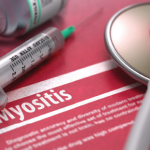The thresholds differ for adults and children. For each population, a total improvement score using a scale of 0–100 is intended to provide a quantitative assessment of degree of response for each patient. This score is the sum of improvement in each of the following six core set measures:
- Physician global activity;
- Patient global activity;
- Manual muscle testing;
- Health Assessment Questionnaire (HAQ);
- Enzymes; and
- Extramuscular activity in adults.
In juvenile DM, the six core set measures can be either from IMACS, as for adults, or from PRINTO:
- Physician global activity;
- Disease Activity Score (DAS);
- Childhood Myositis Assessment Scale (CMAS);
- Patient/parents’ global activity;
- Physical summary score of the Child Health Questionnaire—Parent Form 50 (CHQ-PhS); and
- Childhood HAQ.
In adults, a total improvement score of 20 or higher would be minimal improvement, 40 or higher would be moderate, and 60 or higher would be major. For juvenile patients, a total improvement score of 30 or higher would be minimal improvement, 45 or higher would be moderate, and 70 or higher would be major. According to the authors, these are hybrid response criteria where the same instrument can be used to define response vs. not as a categorical outcome, as well as the magnitude of response as a continuous measure.
Criteria for Everyday Use
Although these response criteria are intended for use in clinical trials, rheumatologists can apply them in day-to-day practice, Dr. Aggarwal says. A Web-based tool and downloadable calculator will be available later this year that will aid physicians in measuring a patient’s degree of response by entering the patient’s score on the core measures. “The Web-based instrument is primarily designed for clinical trials, but can be used by clinicians to assess response in their myositis patients in clinic,” he says.
“Proper quantification of the degree of improvement in clinical practice after therapy is administered to a patient is the cornerstone of any objective evaluation of treatment response,” Dr. Ruperto says. The availability of the criteria and the use of the Web-based tool will allow practicing rheumatologists to properly monitor the degree of response over time, and then discuss with the patient the continuation of or necessary changes to a personalized treatment plan, he says.
Dr. Rider says that the criteria “will advance our ability to detect clinical response in patients. Because we will all be using the same criteria, the same measures, we will be able to compare different trials and therapies. Hopefully different treatments for myositis will be developed that will help patients.”



